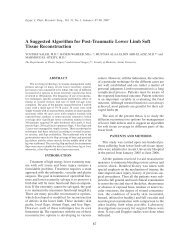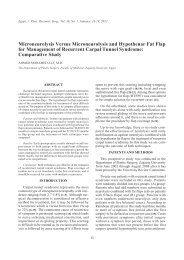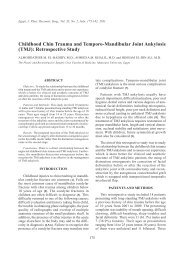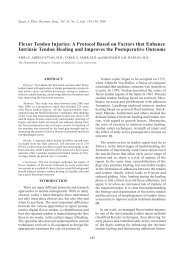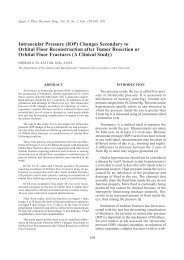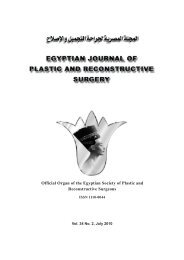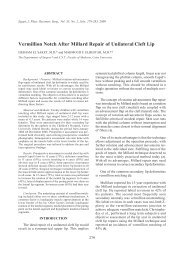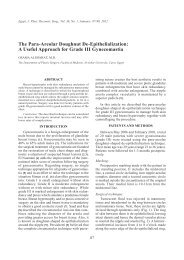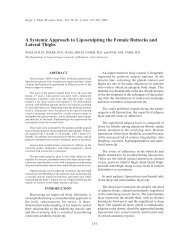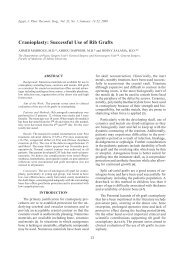Lower Lip Reconstruction with Fujimori Gate Flaps - ESPRS
Lower Lip Reconstruction with Fujimori Gate Flaps - ESPRS
Lower Lip Reconstruction with Fujimori Gate Flaps - ESPRS
Create successful ePaper yourself
Turn your PDF publications into a flip-book with our unique Google optimized e-Paper software.
322 Vol. 27, No. 2 / <strong>Lower</strong> <strong>Lip</strong> <strong>Reconstruction</strong> <strong>with</strong> <strong>Fujimori</strong> <strong>Gate</strong> <strong>Flaps</strong><br />
Fig. (3): Child aged 2 years sustained perioral electric burn resulting in commissural asymmetry.<br />
Fig. (3-A): Preoperative view.<br />
DISCUSSION<br />
Although burn-related injury is the leading<br />
cause of accidental death in the home for children<br />
under 14 years of age, low voltage electrical<br />
burns represent less than 4% of all burn injuries<br />
in children [6]. Gifford et al. (1971) reported that<br />
most low-voltage electrical injuries in children<br />
are around the mouth. These injuries occur most<br />
often from biting on an electrical cord or sucking<br />
on a wall socket. The most frequently affected<br />
site is the upper and lower lip <strong>with</strong> the connecting<br />
commissure followed by the tongue and the<br />
alveolus. The wounds can be extensive <strong>with</strong><br />
thermal injury to the surrounding cheek regions<br />
[7].<br />
Canady et al. retrospectively evaluated 24<br />
patients <strong>with</strong> oral commissure burns who were<br />
treated conservatively <strong>with</strong>out splinting or early<br />
surgery at the university of Iowa. Early surgical<br />
intervention was not indicated because the extent<br />
of soft tissue injury could not be precisely defined.<br />
Patients were allowed to heal their wounds<br />
<strong>with</strong>out splinting of the commissure. To soften<br />
the resulting scars, massage, triamcinolone cream<br />
and vitamin E were used. Prolonged use of splints<br />
was thought to cause excessive scarring, which<br />
could complicate later reconstruction. They<br />
concluded that conservative surgical management<br />
after scar maturation resulted in successful functional<br />
and aesthetic outcomes [1].<br />
Barone et al. retrospectively evaluated 29<br />
patients <strong>with</strong> perioral electric burns. Patients<br />
Fig. (3-B): Immediate postoperative view.<br />
were divided into three groups based on treatment<br />
modalities and were evaluated for aesthetic and<br />
functional outcome. The parameters judged were:<br />
lip length, scar, vermilion quality and lip roll.<br />
Group 1 patients were managed <strong>with</strong>out surgery<br />
and <strong>with</strong>out splints. Group 2 patients were treated<br />
<strong>with</strong> extra-oral splints only. Group 3 patients<br />
underwent commissuroplasty. Although the timing<br />
of commissuroplasty was not clearly defined,<br />
those authors believed that splinting alone provided<br />
the best overall results [8].<br />
Neale et al. reviewed 116 children <strong>with</strong> perioral<br />
electrical burns and also advocated the use<br />
of splints until scar maturation occurred. Once<br />
wounds were completely healed, commissuroplasty<br />
was considered [9].<br />
Earlier studies by de La Plaza et al. of 58<br />
children who sustained electrical burns to the<br />
mouth revealed better overall results <strong>with</strong> aggressive<br />
early surgical management. They concluded<br />
that surgery allows early resolution of<br />
the problem by excision of the devitalized tissues,<br />
<strong>with</strong> shorter hospital stays and fewer operations<br />
to achieve a satisfactory final result [10].<br />
The use of dynamic splinting to prevent<br />
microstomia has gained in popularity. Most<br />
authors believe that better functional restoration<br />
and overall aesthetic results are obtained through<br />
nonsurgical management of these patients using<br />
intraoral splints. The primary drawback of this<br />
type of treatment is noncompliance [2,11].





